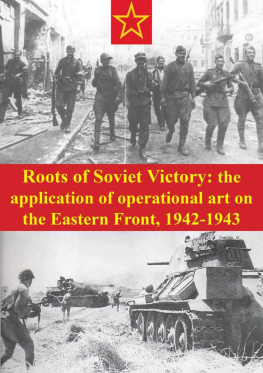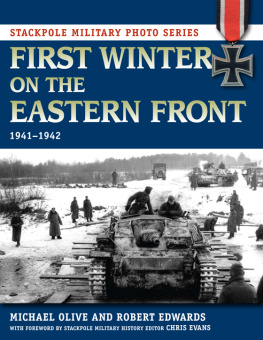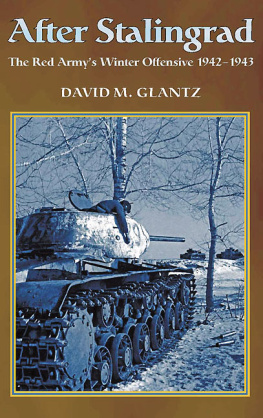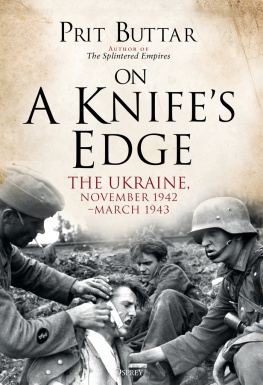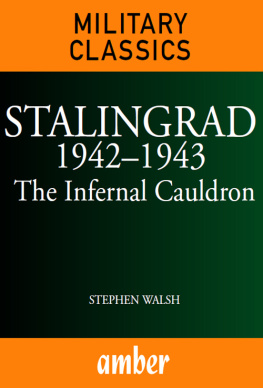This edition is published by PICKLE PARTNERS PUBLISHINGwww.picklepartnerspublishing.com
To join our mailing list for new titles or for issues with our books picklepublishing@gmail.com
Or on Facebook
Text originally published in 1986 under the same title.
Pickle Partners Publishing 2015, all rights reserved. No part of this publication may be reproduced, stored in a retrieval system or transmitted by any means, electrical, mechanical or otherwise without the written permission of the copyright holder.
Publishers Note
Although in most cases we have retained the Authors original spelling and grammar to authentically reproduce the work of the Author and the original intent of such material, some additional notes and clarifications have been added for the modern readers benefit.
We have also made every effort to include all maps and illustrations of the original edition the limitations of formatting do not allow of including larger maps, we will upload as many of these maps as possible.
AN ANALYSIS OF MANSTEINS WINTER CAMPAIGN ON THE RUSSIAN FRONT, 1942-43: A PERSPECTIVE OF THE OPERATIONAL LEVEL OF WAR AND ITS IMPLICATIONS
BY
LTC LAWRENCE L. IZZO, U.S. ARMY
ABSTRACT
This study is a historical analysis of the campaign waged by Field Marshal von Manstein on the Russian southern front during the winter 1942-43. The study begins just after the 6th Armys encirclement in Stalingrad and describes the four principal phases of Mansteins campaign: the attempted relief of the 6th Army; the protection of Army Group A as it disengaged from the Caucasus; the prevention of Mansteins lines of communications from being cut; and the counterblow to regain the initiative.
The lessons learned from the campaign provide a perspective of battle at the operational level of war. The factors leading to Mansteins success are discussed and include: superior generalship at the operational level; superior tactical maturity of the Germans; and German tactical and operational agility. The study describes the transition from the operational defensive to the operational offensive and how a defender can have the initiative. Mansteins use of depth is explained. The concepts of center of gravity and operational art as they pertain to this campaign are also described.
The study concludes with the implications of the lessons learned for a NATO-Soviet conflict in a central European scenario. The study points out that Manstein demonstrated that victory is possible even when forced to react to the enemys plan. The ability of NATO to replicate, today, the agility of Mansteins forces and the synchronization achieved by his commanders is questioned. The implications of NATOs lack of operational depth, in contrast to Manstein, are described. The impact of changes in force design since World War II are also explained.
CHAPTER 1INTRODUCTION
Mansteins Campaign
The winter campaign conducted by Field Marshal Erich von Manstein on the Russian southern front was one of the most brilliant of World War II. It is a classic example of the art of war practised at the operational level; specifically, it demonstrates the use of the mobile defense to wrest the operational initiative from an enemy vastly superior in numerical strength. The campaign can be thought of as beginning with the encirclement of the German 6th Army in Stalingrad in late November, 1942, and ending three months later with the Germans recapturing Kharkov, the 4th largest city in the Soviet Union.
Because the campaign is wedged between two significant German defeats of strategic importance, Stalingrad and Kursk, it has been overshadowed and not received the attention it deserves. But an analysis of this campaign has applicability today for several reasons. First, the principal actor, Field Marshal Erich von Manstein, is considered an operational genius, possibly Germanys best. {1} He played a significant role in developing the German plan of attack through the Ardennes in 1940 which led to the total collapse of France. He won his marshalship with a brilliant campaign in the Crimea in 1941. An analysis of this campaign will demonstrate the finest example of leadership at the operational level.
Second, the campaign is a good example of the operational level of war. The southern flank of the Russian front can be considered a theater of operations by itself, and this campaign represents a series of significant military operations with the ultimate strategic goal of retaining the Donetz Basin, a region of southern Russian thought to have strategic and economic importance by Hitler.
Third, this campaign replicates some of the very conditions we face in NATO today. Manstein found himself initially on both the strategic and operational defensive. German forces along the entire southern front were heavily outnumbered in men and armor. Manstein had to cope with political constraints; e.g., Hitlers insistence on holding onto all occupied territory. This exacerbated Mansteins problems since it restricted his operational maneuver. And Manstein had to deal with an allied army; by the end of the winter he would have Rumanians, Italians and Hungarians under his command.
Fourth, and maybe most important, this campaign offers an excellent example of the transition from the defense to the offense. Ever since Clausewitz said that the defensive form of warfare is intrinsically stronger than the offensive, {2} some have found this difficult to reconcile with the more natural predisposition to attack. But Clausewitz also said that you should wage a defensive campaign with offensive battles {3} and this campaign clearly shows how Manstein parried the Soviet attacks, used the tactical offense whenever opportunity for counterattacks arose and through the cumulative effect regained the operational initiative. Hence the more important question, rather than which form of warfare is strongest, is how do you effectively transition from one to the other.
This paper will first present a review of Mansteins winter campaign. It will then analyze the lessons learned from the campaign, focusing on why Manstein was successful and the Soviets were not. It concludes with a study of the implications of those lessons learned as applied to the tenets of Airland Battle Doctrine in a current NATO environment.
German Operational Overview
As German Army Group South advanced east through the Ukraine during the summer of 1942, its attack began to diverge. Two separate Army Groups were formed, Army Group A, which turned south and attacked through the Caucasus with 2 German armies and Army Group B, which attacked on a broad front towards the Don and Stalingrad on the Volga. The entire southern front became overextended, (this was to become a characteristic of both Soviet and German operations) and offered the Soviets an opportunity to launch their winter counteroffensive. Initiated on 19 November 1942, it had already achieved the encirclement of over 200,000 German soldiers in Stalingrad by the time Manstein was moved from the Leningrad front to assume command of the newly formed Army Group Don on 24 November 1942 and to tie together Army Groups B and A. Under his command he was given the German 6th Army in Stalingrad, 4th Panzer Army and Rumanian Third and Fourth Armies. Manstein quickly realized the crisis he faced represented a decisive campaign and that The issue was no longer the fate of a single Army but of the entire southern wing of the front and ultimately of all the German armies in the east. {4} The overextended German front formed a wide arc curving far to the east to Stalingrad. Its southern boundary in the Caucasus touched the Black Sea on the west and ran east towards the Caspian Sea while facing south. In effect there were two huge salients, one stretching south into the Caucasus and one east into Stalingrad. These salients provided the Soviets an opportunity to cut off several German armies and inflict a decisive defeat even more significant than Stalingrad.




